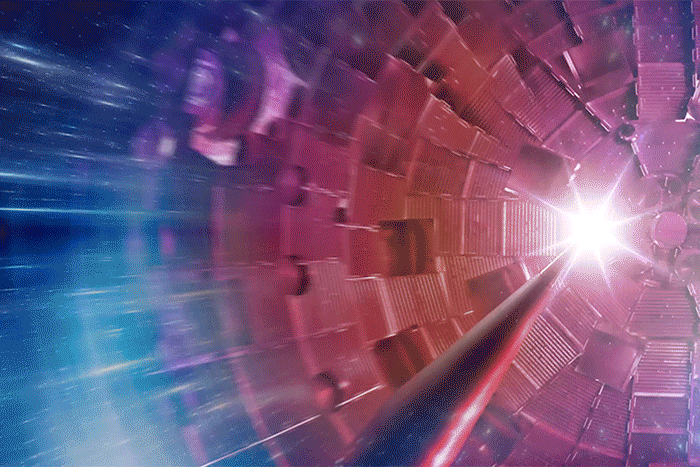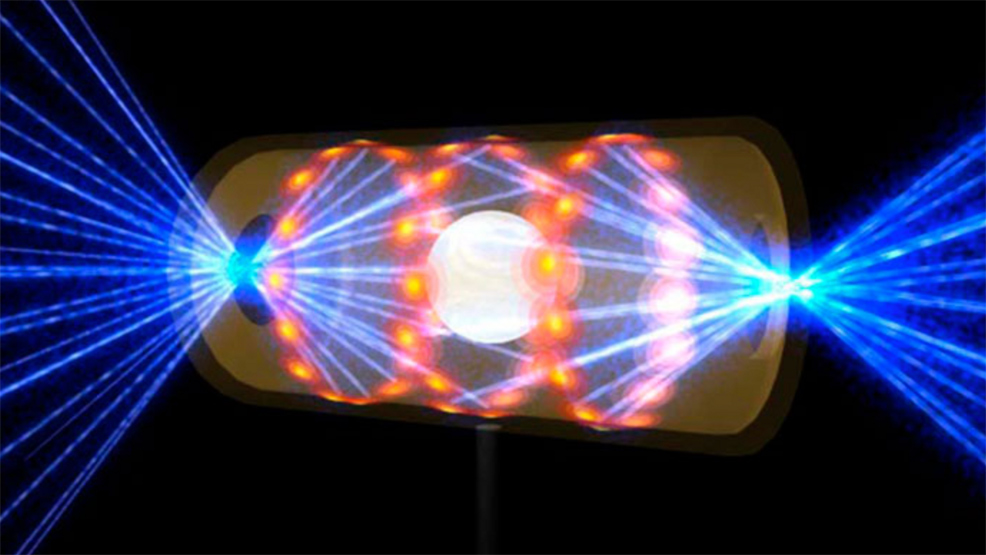
20th August 2021 Fusion breakthrough: 70% yield from input energy The National Ignition Facility (NIF) in California has achieved a major breakthrough in the quest to develop nuclear fusion power. The NIF is the world's largest inertial confinement fusion (ICF) device and contains the world's largest laser. Its 192 beams are housed in a 10-story building the size of three football fields. When combined, these can generate over a million joules of energy, or about 0.1% the amount of a lightning bolt. Scientists have been using the immense power of this laser to heat small capsules of deuterium and tritium (isotopes of hydrogen) in an effort to reach "ignition" and kickstart thermonuclear fusion. This process, the same reaction that powers our Sun, could one day provide a limitless source of clean energy. This week, researchers at the NIF announced the results of their latest experiment. They combined the 192 beams into a 1.9 megajoule (MJ) pulse, fired at a small gold cylinder containing a hydrogen capsule. As the gold vapourised, it produced X-rays that imploded the capsule, fusing its atoms together as it became compressed to 100 times the density of lead. In that brief instant (20 nanoseconds), the pea-sized target heated to 100 million degrees Celsius – six times hotter than the centre of the Sun. This reaction produced 1.35 MJ of energy, more than 70% of the original input.
While the results have yet to undergo a full scientific interpretation and peer-reviewed journal/conference process, initial analysis shows an 8X improvement over previous experiments in spring 2021 and a massive 25X increase over the yields achieved in 2018. The NIF team will now further refine the process and are hopeful of reaching the 100% output required to achieve full ignition. Beyond that, building a practical fusion power system will need production of these laser blasts at a rate of nearly 10 per second to collect energy from the resulting neutrons. Several other reactor types have been demonstrated over the years. Doughnut-shaped devices called tokamaks – which use powerful magnetic fields to contain a superhot plasma for long enough to heat nuclei to fusion temperatures – are perhaps the most well-known, and have been the most successful in terms of research progress. However, this week's breakthrough shows that laser-based fusion is a much more realistic prospect than previously thought. According to the NIF team, a key part of this advance is that the capsules containing the hydrogen pellet are now made of diamond instead of plastic, because it absorbs X-rays more easily. Microscopic bumps and pits on the surface of the fuel capsule have been smoothed out. They also modified the design of the surrounding gold cylinder and improved the precision of the laser pulse to minimise instabilities.
In addition to a much greater energy yield, the scientists believe their experiment also briefly attained a status known as "plasma burning" – a point at which the fusion reactions themselves provide the heat for more fusion, in a chain reaction. This is vital for making the process self-sustaining. "After many years at 3% of ignition, this is superexciting," said Mark Herrmann, PhD, head of the fusion program at Lawrence Livermore National Laboratory, which operates the NIF. "This gives us a lot more encouragement that we can go significantly farther." "I am surprised. They have come close enough to their goal of ignition and break-even to call it a success," said Stephen Bodner, a retired plasma physicist who has long been a critic of the NIF. "It demonstrates to the sceptic that there is nothing fundamentally wrong with the laser fusion concept. It is time for the U.S. to move ahead with a major laser fusion energy program." "The pace of improvement in energy output has been rapid, suggesting we may soon reach more energy milestones, such as exceeding the energy input from the lasers used to kick-start the process," said Prof Jeremy Chittenden, co-director of the Centre for Inertial Fusion Studies at Imperial College London. "Far higher fusion energies can be achieved through ignition if we can work out how to hold the fuel together for longer, to allow more of it to burn. This will be the next horizon for inertial confinement fusion."
Comments »
If you enjoyed this article, please consider sharing it:
|








